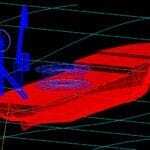Published by Stewart Technologies on March 18, 2016
During off-shore oil and gas production operations, single point moorings provide a safe way to offload petroleum products to tankers, operating as both a buoy system to keep the ship in position and as a connection to the sub-sea pipeline and riser system to move the petroleum products from the production platform to the tanker.

https://youtu.be/Q4T6nv7vRkw&rel=0
Single point mooring systems have several critical parts, and they must all operate together properly to safely and efficiently load the tanker. They must also be able to withstand large forces from the movement of the ship on the ocean, wave action, tidal forces, surface weather, undersea pressures and both horizontal and vertical movements.
Here are some of the most important parts of single point moorings, and how they help to complete the off-loading process successfully:
#1 The Buoy
The buoy typically consists of a set of legs that connect it to the sea floor and a body section, which is located at the surface. The body can freely spin around the leg section, due to a roller-bearing system that permits free rotation. This allows ships that are moored to the buoy to freely move around it, according to the movements of the ocean.
Without this ability to rotate, ships attached to the buoy would exert large amounts of extra force on the buoy system, potentially resulting in a failure of the lines anchoring the ship to the buoy, or the lines anchoring the buoy to the sea floor. During loading operations, this could cause safety problems, as the ship breaks free and moves unexpectedly, or environmental consequences if it causes a spill of petroleum products.
A properly-designed buoy system should be able to handle all the horizontal, vertical and rotational forces exerted on it while safely delivering oil or gas to the tanker.
#2 The Anchoring System
The buoy is attached to the seafloor with either anchors or a pile system, in most cases. Anchors provide a temporary attachment system by sinking a large mass, such as concrete, to the sea floor to provide a stationary weight, by embedding into the seafloor itself, or by attaching to an existing sub sea feature, such as a large mass of rock or a crevice. For a more permanent attachment system, piles can be driven into the seafloor to provide a solid anchoring system.
Once the anchor and the buoy are in place, anchor chain, or sometimes synthetic or metal cables, are run from the anchors or piles on the seafloor up to the buoy itself, providing a secure attachment.
Each of the components in the anchoring system must be able to withstand the corrosive effects of salt water, as well as the natural forces of the ocean, including waves, weather, and pressure. Most anchoring systems are built to withstand some small amounts of movement, which helps prevent fatigue and the structural failures that can result from the forces acting against the system.
#3 The Petroleum Loading System
The buoy is connected to a pipeline system that is located on the seafloor. This pipeline carries oil or gas from the well and distributes it through a pipeline end manifold to a system of risers that bring it to the surface of the ocean. These risers are typically flexible, allowing them to move along with the ocean currents and the movements of the buoy.
At the surface, the risers connect to the buoy, and the oil and gas is routed through a swivel system in the buoy’s body, allowing the output connections for the petroleum products to swivel along with the moments of the ship. The final connection from the buoy to the tanker is typically made with a floating hose system, which features breakaway connectors that prevent oil spills if the ship moves too far away from the buoy.
The swivel system contains a number of valves and seals that prevent oil or gas leaks, as well as supplemental connections for power, data or electrical signals in many cases. All of the seals and electrical connections are constantly subjected to rotational forces, friction and some horizontal and vertical movement. They must be carefully designed to withstand all of the stresses experienced during operation while minimizing the amount of maintenance required and the associated costs.
#4 Ship Mooring System
The deck of the buoy features a mooring point, to which one or two synthetic ropes are attached, depending on the size of the ship. The ropes are extended out to the tanker, where they are connected to a chafe chain that is extended from the tanker. The connection allows the ship to rotate around the buoy, and the floating hose system moves along with the ship. Each component must be carefully designed to handle the weight of the ship and the forces exerted on it by the movement of the ocean.
Optional Components
Typically, the buoy will have a boat dock for personnel to easily access the deck, as well as fenders or bumpers to prevent damage to the buoy. It may also have an integrated power system, weather equipment, navigation aids, or cranes and other equipment for maneuvering large loads, as well as safety equipment.
Improving the Design of Single Point Moorings
To design a long-lasting and structurally-sound single point mooring system, it is wise to invest in both a structural design analysis and a hydrodynamic analysis. By scrutinizing the structural components and modeling how each behaves under the conditions present in a marine environment, including wave action, high pressures, tidal forces, variable weather and corrosive forces, the design of each component can be optimized to ensure that it will perform well under the worst conditions, with a suitable design life and minimal maintenance. With hydrodynamic analysis, every possible component can be modeled and improved, from the shackles connecting the mooring lines to the anchoring system, to the buoy itself.
With a properly-designed single point mooring system, operational costs can be significantly reduced, production efficiency can be increased, safety can be improved and the environment can be better protected.
Sources:
https://stewart-usa.com/mooring-analysis.php
https://stewart-usa.com/hydrodynamic-analysis.php
http://petrofed.winwinhosting.net/upload/18Sep10/1.pdf
http://www.rigzone.com/training/insight.asp?insight_id=308&c_id=17


